TMW #129 | The composability idea
Welcome to The Martech Weekly, where every week I review some of the most interesting ideas, research, and latest news. I look to where the industry is going and what you should be paying attention to.
👋 Get TMW every Sunday
TMW is the fastest and easiest way to stay ahead of the Martech industry. Sign up to get the full version delivered every Sunday for this and every TMW, along with an invite to the TMW community. Learn more here.
Some news: I’ll be speaking at Mops-Apalooza by Marketingops.com in Anaheim, California this November. It will be a little different from my usual talks - I’ll be unveiling the results of a new TMW product that launches next week. Check out the event here.
The composability idea
Every once and a while, a new idea hits a community and becomes a new reality. Whether that be a group of high school kids, a market, a viral meme or an entire country, a strong idea with buy-in from enough of the right people can quickly become the new status quo.
And the success of what I call “idea saturation” – the breaking point where something new becomes a norm – doesn’t rely on the idea being good at all. In fact, some of humanity’s worst ideas have been embraced by hundreds and millions of people.
Take, for example, communism. It was a fringe idea propagated by anarchists and violent radicals until a very small socialist political party took an opportune moment to become a mainstream political movement that spread across the East. This set of political and social ideas led to untold human suffering.
I’m obviously pointing out a clearly disastrous idea here. But idea saturation has also brought us the smartphone, the internet, democracy, and all kinds of good regulation. When it comes to how we work, live and what we invest time, capital, and effort into, ideas set the directional foundation for whatever outcomes we’re chasing.
In Martech, there’s a new idea escaping confinement right now – and that is the idea of composability. You might have heard of it – it’s a relatively new way of thinking about how enterprise companies manage the various tools in their Martech stack. My question to the idea of composability is this: is it a good idea or a bad one?
The cool new thing
Composability is set to become the mainstream way of thinking about how managers invest in technology to do marketing at scale. So much so that famous Silicon Valley VC firm A16Z recently wrote an analysis of the concept, where they framed the potential of composable Martech as this:
“As the core pieces of data infrastructure continue to mature, consolidation is happening on the backends toward data warehouses and event-driven architectures. These composable and adaptive backends enable a new wave of interaction on top of shared data models, which makes the collection, analysis, and dissection of customer data much more tenable and shareable across different teams.”
As investors start to pick up on this new trend, consultancies are going after it too. For instance, Merkle recently did a long webinar on the concept of composability with Rudderstack, where they presented a new (and vendor-led) vision for the composable CDP with modular technologies that can be shifted around a central data hub that can be configured, swapped out and changed easily.
And of course, Gartner has been focusing intently on “the composable business.” On a research call, Tomasz Anioł from Storyblok, mentioned that in a few short years, Gartner has racked up more than 550 articles on their blog on this topic. Gartner is going so far as to say that by 2024, the default way of thinking about SaaS will be composable and API-first. And it’s not hard to see that prediction coming true – over 2022, composable technologies reached 15-20% of market penetration.
Why? Gartner’s most recent survey into the difference composability makes in business paints a stark picture of the composable business as the better-performing business.
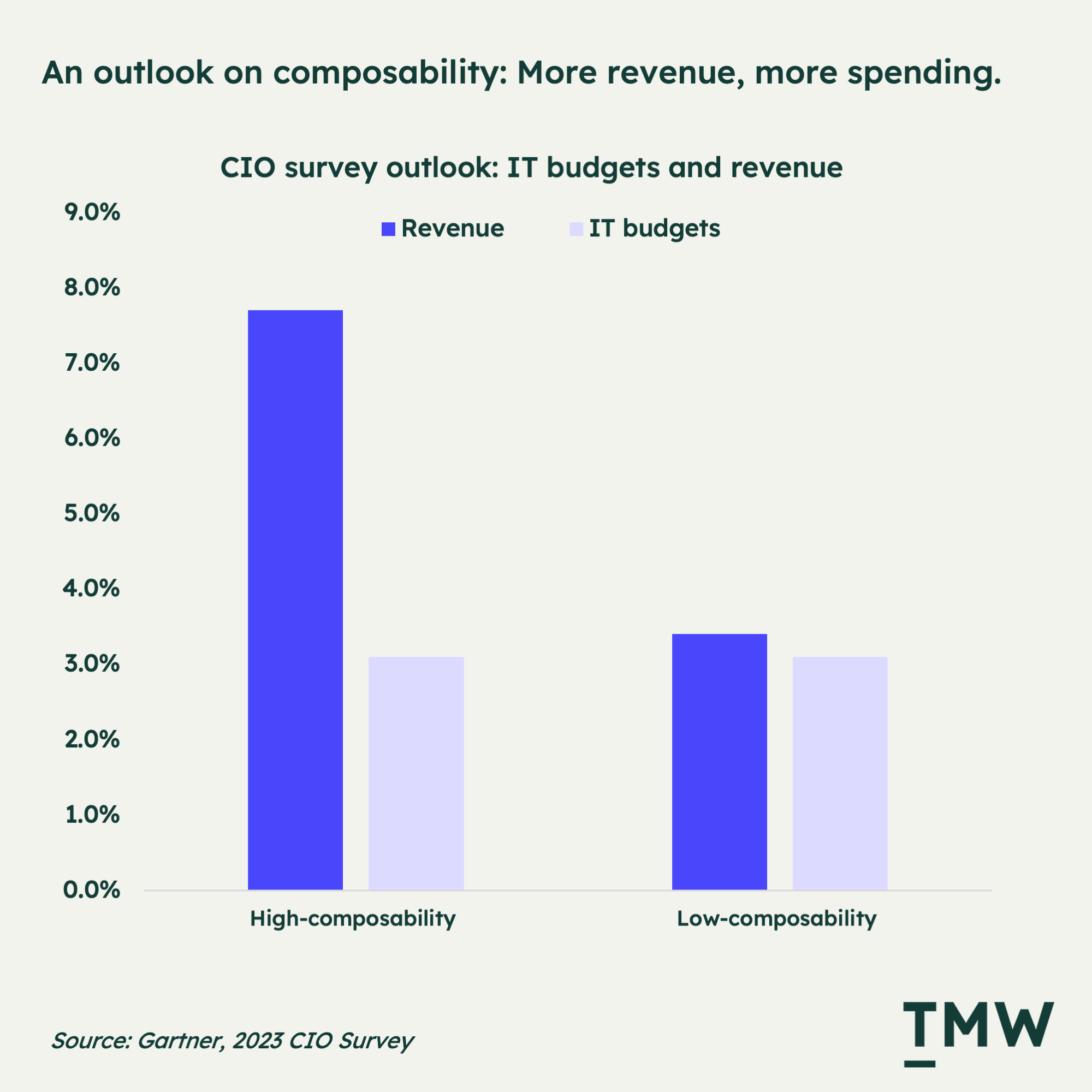
But the idea of composability isn’t new at all. In fact, the idea of composable technologies was born out of the e-commerce category to describe how new startups were building technologies to decouple the e-commerce engine that handles transactions, inventory and order management from the content and experience layer.
What triggered the shift to composable in e-commerce was a platform shift to mobile, driven by the iPhone and, later, Android OS in the late 2000s. This brought fresh challenges to the once-simple software solutions that were designed for desktop websites. Device responsiveness with website design, integration with mobile apps, and more customer touchpoints created pressure to innovate and capture a fast-moving cohort of customers using mobile technology to buy things.
Here’s Tomasz Anioł’s assessment of this shift:
“5 years after launching the first iPhone, when mobile buying became a thing, the eCommerce industry got a big technology shift to handle. That was the driving force behind detaching customer interfaces (frontend) from the rest of the stack (backend). This approach was coined around 2012 as “headless” - platforms that can serve many touchpoints (heads). Since the name was technical and reached the mainstream in a decade it started to be confusing for business stakeholders. An understandable term was needed so Gartner coined “composable” and now predicts that, by 2024, it will be a mantra for new SaaS vendors.”
Hilariously, Dirk Hoerig, the founder of Commercetools, coined the term in 2012 to differentiate between a single-head e-commerce platform and a multi-headed approach, but says he regrets coming up with the word if he had known that the idea would catch on so widely. This is how Hoerig defines headless commerce, which has so many striking similarities to a lot of the mainstream definitions out in the market for composability:
“It is a technology platform that exposes all functionality and data through individual APIs , ideally operating on top of a microservice.”
As the idea of headless commerce evolves (or devolves) into the concept of composability, more consulting firms are starting to push these ideas. Gartner was the first to have really defined what was happening in the decoupling of back and front ends in e-commerce as “composability.” Now we know who to blame for giving the world a new buzzword.
The idea of composability already has a lot of rich historical content when applied to emerging categories appropriating the idea for customer data platforms and digital experience platforms. And so, is what we’re seeing here a form of idea recycling? Taking something that works in another category and applying it elsewhere? Perhaps.
To answer that question for the customer data platform space, we need to define what composability is, and how the idea is changing.
A conceptual shift
The idea of composability goes deeper than a speculative hype bubble in B2B technology management. Tejas Manohar and his team at Hightouch claim to have invented the idea of composability as it applies to the CDP. So, curiously, I reached out to Tejas to ask him about how the industry is defining it. Here’s what he said:
“Composable CDPs leverage the data & technology you already have - to deliver self- service personalization quickly with flexibility and scale. The conversation around composability isn’t wrong. It’s incomplete. All of the focus is on the modularity - which often raises ideas of complexity and integration. What’s missing is that composability is also a story of automatic backwards and forwards compatibility — the ability to leverage the data and technology you already have to deliver value quickly and fill in the gaps over time”
And as I’ve been watching Hightouch and other warehouse-native data activation companies extend into new domains like Adtech, analytics and the customer data management space by building this kind of combability for the data warehouse, there’s been a real conceptual shift here. It’s happening right across the industry, and now marketers are embracing the data warehouse to enable more parts of their marketing technology stack.
Most marketers look at composability and think it’s about building your own technology, API layer, or platform. But I don’t think this captures the spirit of composability; companies often build their own internal monoliths that don’t integrate with anything and become a huge blocker to progress and we don’t call that “composable Martech”. Composability does not equal building custom tech.
Instead, composability has this organizing idea in it that in order to be flexible enough to cope with technological change, privacy regulations and changing consumer expectations from online channels, Martech should be malleable. But more importantly – and to Tejas’ point – Martech needs to become more compatible with other solutions to fit into a proper definition of composability.
And this is especially true as the industry is seeing a greater pullback in marketing spending on Martech. Battery Ventures has compiled a report on enterprise software spending and found that vendor consolidation and optimizing SaaS licensing spend are the top priorities for CXOs this year. 93% of them said that consolidation of technologies in their stack is their top priority.
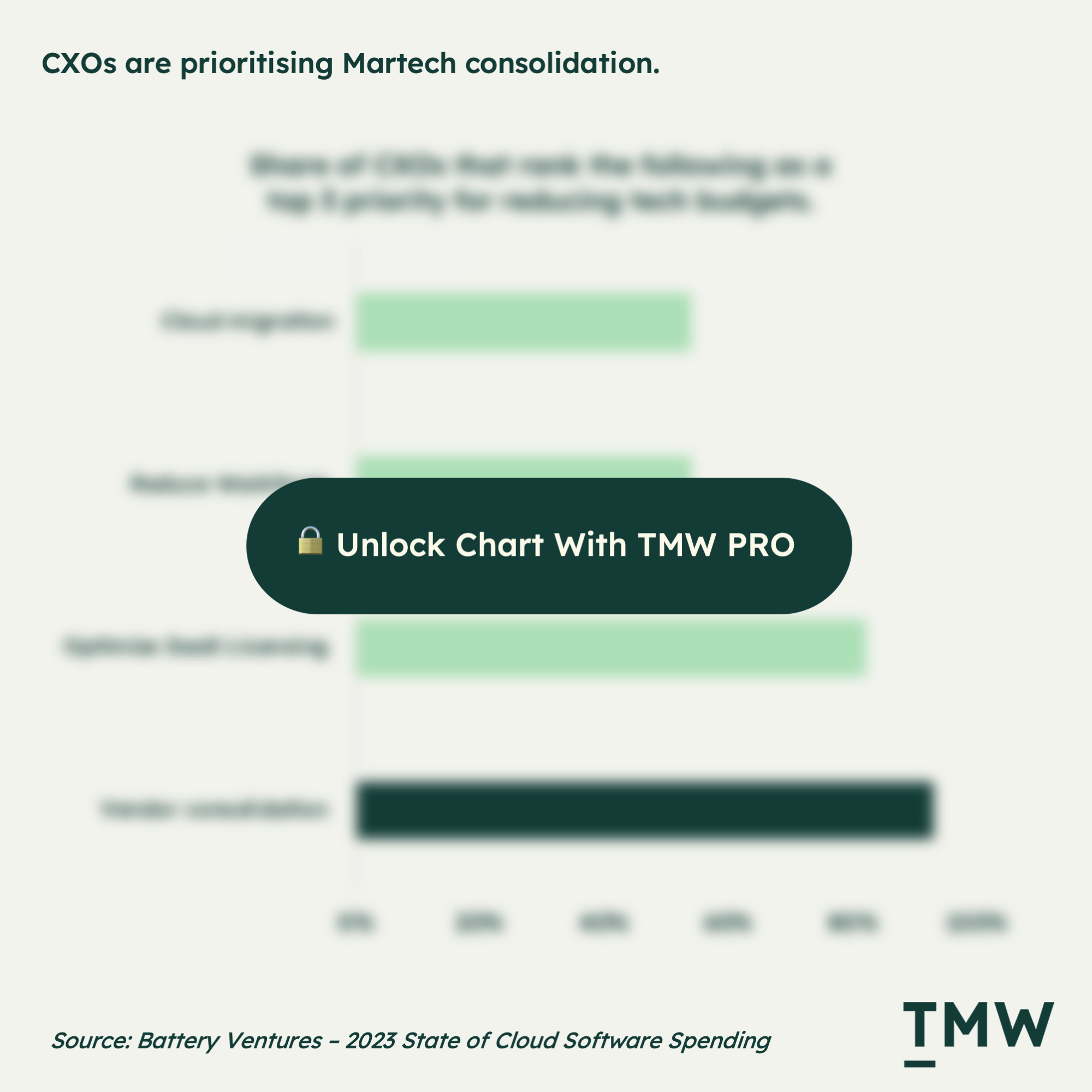
Other reports like Gartner’s CMO spend outlook for 2023 confirm the overall trend in software spending for marketing: we’re now firmly in a cooling market, with 75% of CMOs in the United States under pressure to cut spending and focus to return on investment activities. Hilariously, in this report, Gartner equates CMOs that do spend on Martech as desperate gamblers looking to bet on uncertain technology choices.
One of the reasons for this is the volume of vendor lock-in that happens in marketing technology. We have far too many “suits” that do it all – that sell to hapless digital and marketing teams a belief that everything is possible in a single platform – which in reality is a dubious tactic to lock companies into a platform so they can never leave.
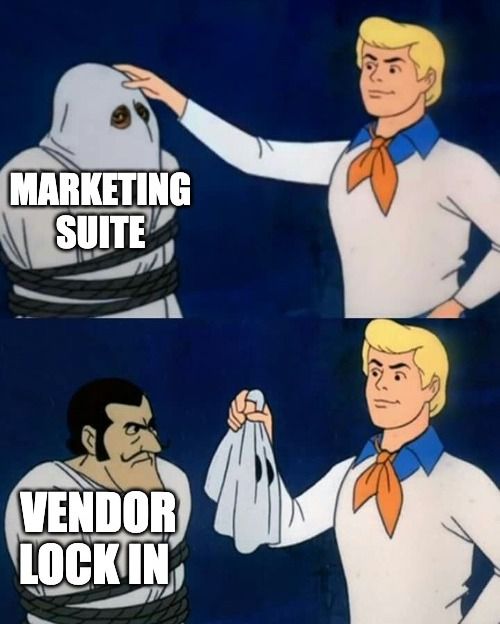
Of course, the incentives to do this are overwhelming for tech companies; it improves their LTV/CAC ratio and gives investors a good story about low churn and high loyalty. But in reality, very few of these all-in-one suits are being utilized to their fullest extent.
Manuela Tchoe frames some of the interesting benefits of shifting away from monolith products to more modularized, best-of-breed technologies, recognizing that the promise of all-in-one platforms has failed the market:
“A best-of-breed approach solves these issues by allowing you to choose the ideal tools for your digital commerce experience. Instead of a pre-packaged solution, you can plug in the components that best suit your business needs. It means you don’t have to sacrifice functionality according to a vendor’s limitations. In short, instead of using a Swiss army knife for everything (imagine dicing vegetables or cutting cloth with one toolset), you get specialized tools for your unique use cases without vendor lock-in. After all, it’s unlikely that an all-in-one platform can provide a top-notch service encompassing all of the components needed to build a digital commerce platform, such as a CMS, payment, search, etc.”
As I mentioned in TMW #111 | Unbundling Salesforce, there has to be a limit to how many different technologies bolt onto their extremely dated CRM software. And over the years new categories have emerged to take slices away from the six divisions of the Martech monolith that is Salesforce. In this way, composability is a trend that gives greater market power to startups.
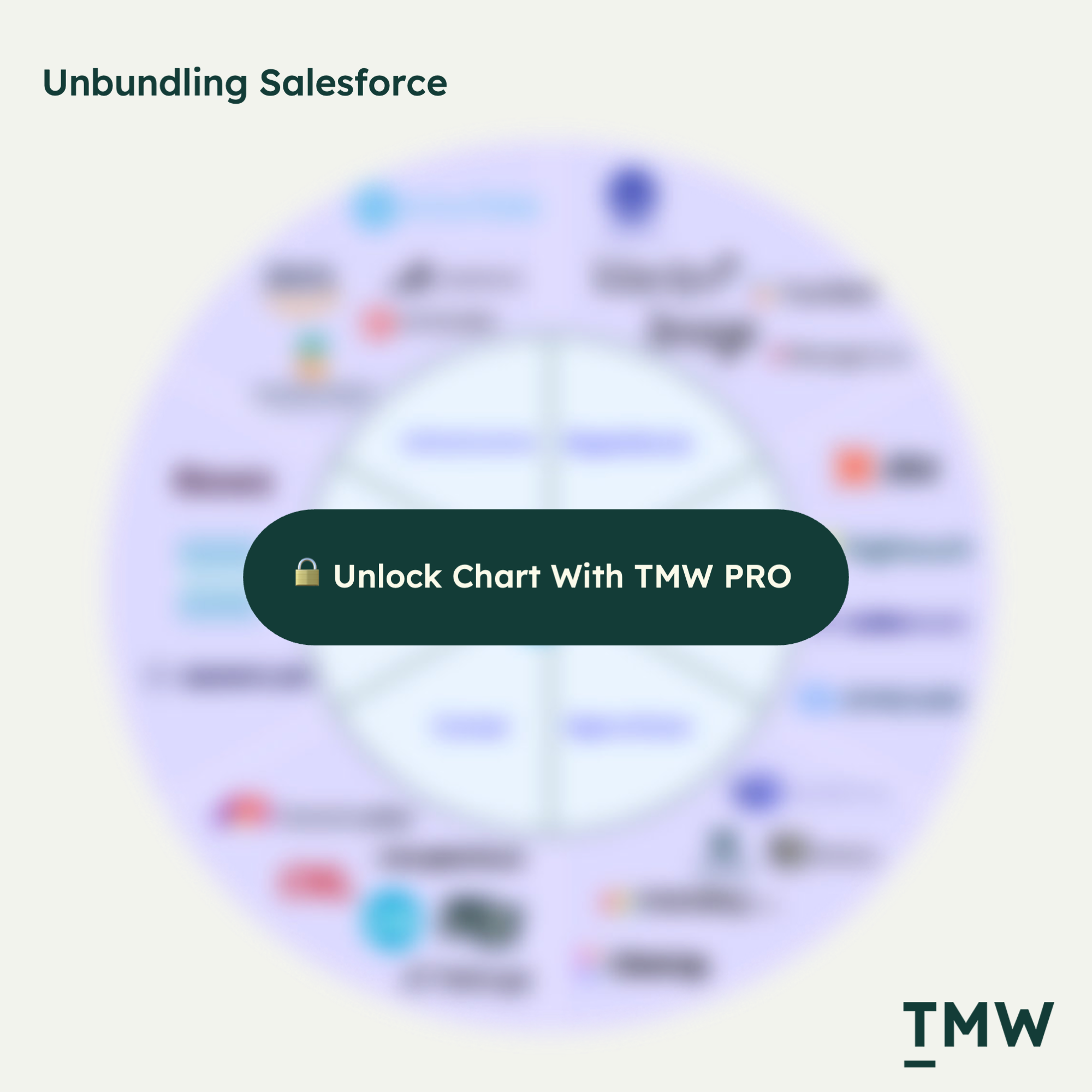
And so when you have an atmosphere of distrust for all-in-one platforms that purports to do it all, this breeds an opportunity for new startups to define fresh ways to think about solutions. I believe that composability is one of those solutions to vendor lock-in. But there are still a lot of challenges with the argument for composability.
The problem with the composability argument
Composability and the data warehouse are frequently talked about together. This brings me to a question: aren’t we just replacing marketing suits with the data warehouse? There always needs to be some kind of centralized and hard-to-change platform involved, because the data needs to be stored and managed somewhere.
The data warehouse could introduce a ton of new problems with vendor lock-in that prevents company flexibility. Besides, year-on-year growth in data warehouse spending is slowing down. Slowing spending means less marketing-compatible innovation in the data warehouse space, and then we’re back to square one.
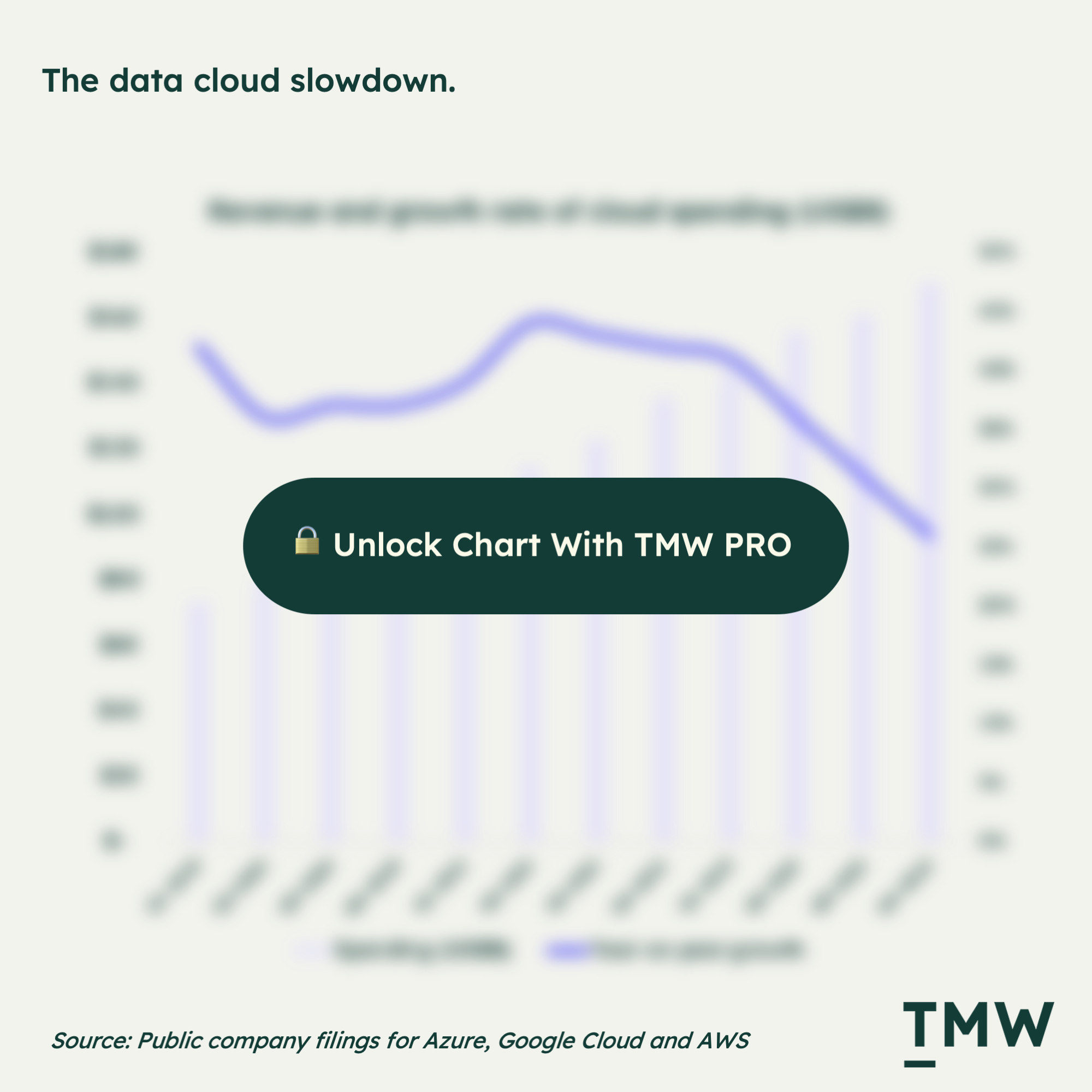
Another way to think about it is that true composability can also mean having multiple CDPs, multiple marketing operations systems, and multiple sources of data if your business strategy requires it. I think the conceptual shift of composability isn’t only to use the data warehouse for all your marketing needs. It’s to decouple internal business software and data from channels as much as possible.
Besides, this alternative argument means that while you might be spending less with any one vendor, you’d probably be spending on more apps. Training, integrations, and orchestration are all overheads required to manage more apps in a stack.
For example, how do you “compose” your first-party data for email marketing and programmatic advertising from a single source of data? Maybe you’d want to have a CDP that does both, so you get the best possible results from use case-focused software for advertising and email. There are now more than 160 CDP vendors of all different flavors, shapes and sizes and so with a composable outlook you could use multiple similar tools for specific and valuable use cases.
Joe Cicman argues that the ability to integrate applications together is nothing new. So what exactly are we talking about here? I think the main shift is creating an imperative (and incentive) for Martech companies to build software that is less monolithic and more modular, less commandeering and more compatible with everything else going on in the stack.
ActionIQ has three angles on their definition of the composable CDPs: First is “zero-copy architecture” – the ability to manage customer data without having to duplicate across systems. Second, “warehouse agnostic,” which means that the stack can adapt to new sources of data and is not highly reliant on a single source of truth to function. And third, it has no code UI, which allows marketers to make changes, build experiences and gain insights without overburdening the development teams.
The three-point framework for composability in the CDP category is helpful, but still incomplete when reduced down to focusing only on data. Composability is also about how content is managed across the Martech stack, and how teams form and work together. It’s also about privacy and compliance. That’s why composability is more of a business philosophy than purely a way to think about managing data.
The right idea
There’s no doubt in my mind that composability will become a dominant view in Martech over the coming years. One of the ways it gets there is by presenting the idea in a way that’s easily relatable. And in this industry, you do that with metaphors.
I’ve now heard a variety of colorful word pictures to describe the role of composability for marketers, from restaurants and Lego to music. In my research call, Tejas offered a view of composability as a way to see your Martech stack as a bunch of Legos, which can be a helpful way to think about what to look for in a Martech solution that offers features that are composable:
“Think about the Lego example. We tend to focus on the fact that Legos are a bunch of building blocks. We forget the real innovation of Lego is just two things - their compatibility and ease of use. As for compatibility, every Lego made ever since 1958 is compatible. As for ease, Lego makes it so that any child can build literally anything, easily with their imagination. Composability, as it relates to CDPs, is about making it easy to start personalizing using the data and technology you already have on top of a scalable foundation that is naturally compatible with your past investments or future plans"
The concept of interoperability (a brick can fit with any other brick) is an interesting vision for where Martech may go next, and in 2023 we really shouldn’t need to wait weeks for a developer to send data from one point to another. But where it falls down is that you still are using Legos for everything and the metaphor betrays the difficulty and training needed to build a marketing technology stack that is modular and flexible. I grew up in a household playing K’nex, the ugly cousin of the Lego brand. They don’t work together. (Yes, I had a harsh childhood).
A superior view is that the right idea for composability is in the word – compose – which traditionally means writing your own music. If you’re a composer, you take musical notes and arrange them into a series of patterns and sounds to make something beautiful. It’s a bit silly to bring this metaphor into this discussion – I mean, we’re not Elton John – but stick with me.
Composability is not about inventing new music notes or building new instruments – it’s about the flexible and dynamic nature of using different technologies in a modular fashion to create something wonderful for your customers. Different instruments with different players that are trained to use those instruments should be playing from the same songbook to handle all the nuances of a marketing technology strategy.

Another thing is that composability is not effective when seen in isolation. I consider an equally confusing word – omnichannel – to complement the role of composable technologies in a business.
If composability is about the internal business processes and technology coordination, then omnichannel is about the external experience provided by the customer to make it more consistent, congruent, and readily available when customers want to interact with a brand. Omnichannel is the experience goal; composability is the organizationl goal.
But I think at a philosophical level, there’s something to say about how we think about the customer journey and the role technology plays. Aarron Spinley suggests in a soon-to-be-released report that customer experience is its own stack with offer integrity, services, and experience layers. All three facilitate customer goals and require technologies to make it happen. For example, offer management is very different from customer journey orchestration, but they need to be compatible with each other to facilitate an omnichannel experience for a customer.
We can get too involved in the actual technologies themselves, and like most mistakes in Martech, you get into trouble when there’s no clear strategy for what you’re buying and implementing in a business. Orienting back around the customer and what marketers actually need, composability is a technological shift that should be in service of this goal, and if what we’ve learned from the past decade in SaaS, all-in-one (non-composable platforms) and vendors that lock customers into data ecosystems and channels are not working.
So, is composability the right idea? At the very least, there’s something powerful about giving marketers greater flexibility and control over how they enable their practice with data and tech. But what we’re asking of businesses is to invest more, have more patience to get to a result, and increase the total sophistication of marketers that orchestrate the orchestra.
Composability is hard work because Martech vendors don’t play ball by limiting compatibility and usability to serve their own growth and retention goals. But if the idea starts to become the mainstream way of thinking about marketing technology architecture, it might actually force some of the larger companies in the industry to become more flexible and usable.
Besides, I for one would like to see marketers write their own songs instead of letting technology vendors write them – and that is the promise of composability. You get to write your own song with any instrument you like.
Stay Curious,
Make sense of marketing technology.
Sign up now to get TMW delivered to your inbox every Sunday evening plus an invite to the slack community.
Want to share something interesting or be featured in The Martech Weekly? Drop me a line at juan@themartechweekly.com.
